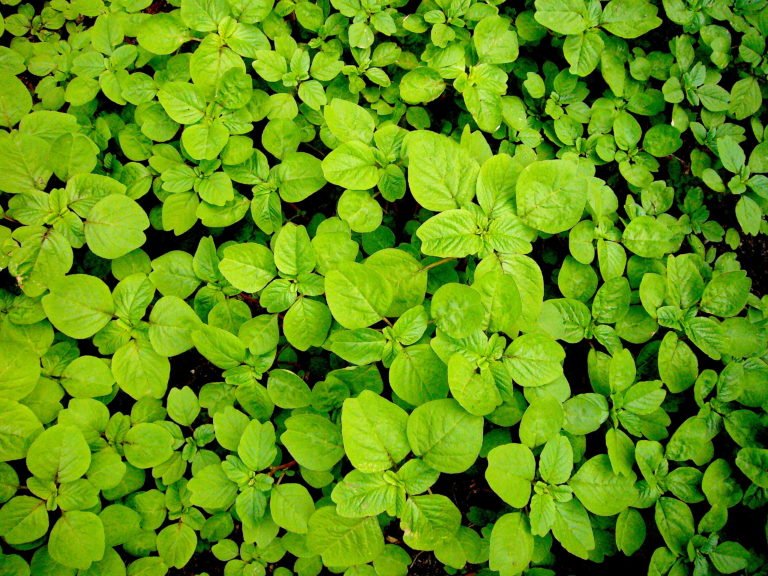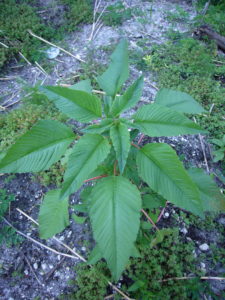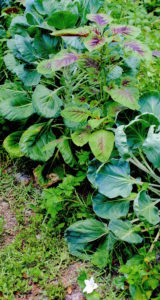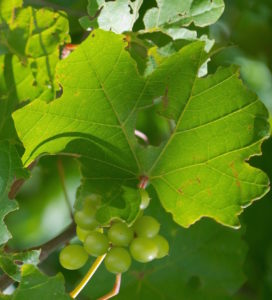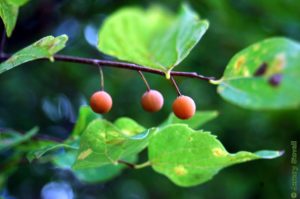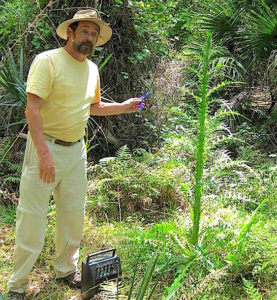In one way Amaranths are like grapes: It’s fairly easy to tell if you have an Amaranth as it is easy to tell if you have a grape. Which species, however, can often be elusive. There are scores of Amaranths. Locally there are perhaps a dozen or so among them Amaranthus albus, australis, blitoides, gracilis, hybridus, palmeri, retroflexus, rudis, spinosus, tuberculatus, and verdis. Besides the ones highlighted below the two most common ones are A. hybridus (pictured above) and A. verdis.
One of the more interesting Amaranths is also among the least written about because it isn’t much of a threat to agricultural crops, A. australis or the Southern Amaranth. Instead of populating farmland like the dreaded Palm Amaranth it likes brackish and freshwater marshes, river and pond shores. It’s big, often 10 feet tall with the world’s records over twenty feet. The Southern Amaranth has edible leaves and seeds, the leaves preferably when young and cooked. Oddly Native Americans did not pass on much information about their usage of the this amaranth. It’s one of those foraging mysteries, a very obvious plant and very little native information about it. They are also hard to ignore. Anytime you are in The South near water and you see a 15 foot tall herbaceous plant it’s likely the Southern Amaranth.
The Spiny Amaranth, A. spinosus, is also fairly easy to identify because it hurts you. It has edible seeds and leaves but the plant itself has numerous spines that prevents most of it from being eaten. The spines are in pairs, very sharp and stiff, growing at every node (where leaves grow out.) Two other Amaranths are also fairly easy to sort out. Prostrate Pigweed, A. blitoides, is small and low-growing. It is common in dry open fields, pastures and roadsides north of the coastal south though it can be found along the east coast from the Carolinas north. This is the runt of the genus and more resembles a basal rosette than its taller relatives. A greater pest Amaranth and one that has to be eaten young, is Palmer Amaranth, A. palmeri. Odd for an amaranth it has male and female plants and has beaten the chemical industry by becoming immune to the herbicide Round Up. But as it also grows on fallow agricultural soil it can take up sickening amounts of nitrates so it should be eaten only when young.
As for grapes, the natives look as if they will be early this year. I usually look for grapes in September but his past weekend during a foraging class in Orlando some of the wild grapes were starting to ripen. Some of our native grapes are controversial, especially Vitis rotundifolia and V. monsoniana. They are actually in a subgroup called Muscadinia and some botanists want them taken them out of the grape genus altogether and made a new genus called Monsoniana. Whether this change succeeds only time will tell. Botany is not as cut and dried as hay.
This is also a good time to identify sugarberry trees, also called hackberries. They have four fairly easy characteristics to look for. Sugarberries can be large trees usually growing near water but not in it. This is not a species you will find on the top of a hill unless there is a lake or spring there or good irrigation. It’s usually found in the company of sweet gums, pecans, ash, cedars and what is left of elms (whose family it is in.) The bark of older trees is very warty but no thorns. Sugarberry leaves usually have uneven shoulders and if you flip the leaf over there are thee main veins at the base. And this time of year you will see small pea-sized green berries. These will turn yellow to burnt orange in color in a couple of months, sometimes even darker towards purple. Very sweet with a large seed. The entire fruit is edible though the seed is on the hard side. Natives often mashed the entire fruit making them into small cakes to be eaten raw or cooked. You can read about the sugarberry here.
Upcoming Foraging Classes:
Sunday, July 10th, Red Bug Slough Preserve, 5200 Beneva Road, Sarasota, FL, 34233. 9 a.m.
Sunday, July 17th, Wickham Park: 2500 Parkway Drive, Melbourne, FL 32935-2335, 9 a.m. Meet at the dog park inside the park.
Sunday, July 24th, Bayshore Live Oak Park, 2200 East Lake Road, Port Charlotte, FL. 9 a.m. We meet at the parking lot across the street from Ganyard Road.
To read more about the classes go here.
Want to identify a plant? Perhaps you’re looking for a foraging reference? You might have a UFO, an Unidentified Flowering Object you want identified. On the Green Deane Forum we — including Green Deane and others from around the world — chat about foraging all year. And it’s not just about warm-weather plants or just North American flora. Many nations share common weeds so there’s a lot to talk about, such as the one to the left. There’s also more than weeds. The reference section has information for foraging around the world. There are also articles on food preservation, and forgotten skills from making bows to fermenting food. Recent topics include: Is This A Young Dandelion? Looks Like A Thistle Flower. Mint? Is This A Gopher Apple? No Flower Too Wrong, Apple-Like Fruit, Pink-White Flowers At The Nodes, Field Plant, Woodland Perennial, Frilly Pink Blossom, Hopefully Groundnut. Bane of my Efforts. Tiny Hypericum. Snake Boots, Unidentified Cane Plant, Small Green, Scrub Jays!, Type of Magnolia, Water-Loving Weed, and Piper auritum, the tropical sassafras. You can join the forum by clicking on the button on the upper right hand side of this page.
 All of Green Deane’s videos are available for free on You Tube. They do have ads on them so every time you watch a Green Deane video I get a quarter of one cent. Four views, one cent. Not exactly a large money-maker but it helps pays for the newsletter. If you want to see the videos without ads and some in lightly better quality you can order the DVD set. It is nine DVDs with 15 videos on each. Many people want their own copy of the videos or they have a slow service and its easier to order then to watch them on-line. They make a good gift for that forager you know. Individual videos can also be ordered. You can order them by clicking on the button on the top right of this page or you can go here.
All of Green Deane’s videos are available for free on You Tube. They do have ads on them so every time you watch a Green Deane video I get a quarter of one cent. Four views, one cent. Not exactly a large money-maker but it helps pays for the newsletter. If you want to see the videos without ads and some in lightly better quality you can order the DVD set. It is nine DVDs with 15 videos on each. Many people want their own copy of the videos or they have a slow service and its easier to order then to watch them on-line. They make a good gift for that forager you know. Individual videos can also be ordered. You can order them by clicking on the button on the top right of this page or you can go here.
This is Newsletter 215.
If you would like to donate to Eat The Weeds please click here.

